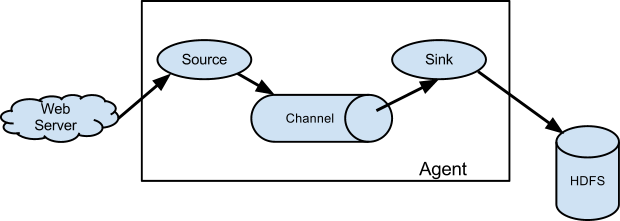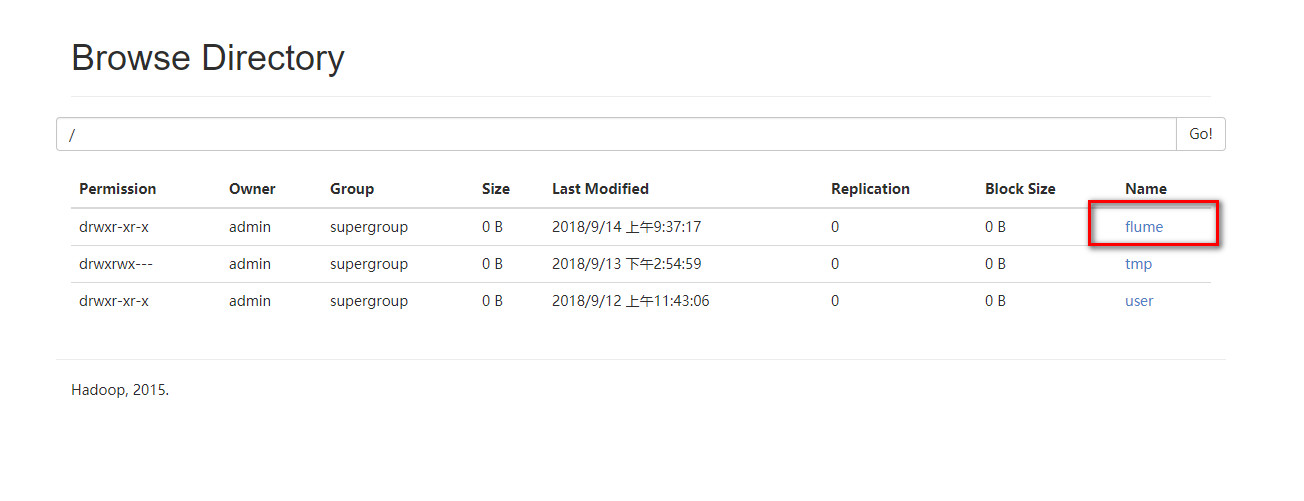Flume简介 --(实时抽取数据的工具)
1) Flume提供一个分布式的,可靠的,对大数据量的日志进行高效收集、聚集、移动的服务,Flume只能在Unix环境下运行。
2) Flume基于流式架构,容错性强,也很灵活简单。
3) Flume、Kafka用来实时进行数据收集,Spark、Storm用来实时处理数据,impala用来实时查询。
Flume角色

1、Source
用于采集数据,Source是产生数据流的地方,同时Source会将产生的数据流传输到Channel,这个有点类似于Java IO部分的Channel。
2、Channel
用于桥接Sources和Sinks,类似于一个队列。
3、Sink
从Channel收集数据,将数据写到目标源(可以是下一个Source,也可以是HDFS或者HBase)。
4、Event
传输单元,Flume数据传输的基本单元,以事件的形式将数据从源头送至目的地。
Flume传输过程
source监控某个文件或数据流,数据源产生新的数据,拿到该数据后,将数据封装在一个Event中,并put到channel后commit提交,channel队列先进先出,sink去channel队列中拉取数据,然后写入到HDFS中。
Flume部署及使用
1.下载并解压到指定目录
$ tar -zxf ~/softwares/installtions/apache-flume-1.7.0-bin.tar.gz -C ~/modules/
2.重命名文件,且修改配置文件。
cd /home/admin/modules/apache-flume-1.7.0-bin/conf 将所有带有template的文件去掉template 修改配置文件 flume-env.sh (只需修改你对应的java安装路径即可) export JAVA_HOME=/home/admin/modules/jdk1.8.0_131
使用案例
案例一 :端口数据监控
1.先安装telnet,telnet rpm包 下载
$ sudo rpm -ivh xinetd-2.3.14-40.el6.x86_64.rpm $ sudo rpm -ivh telnet-0.17-48.el6.x86_64.rpm $ sudo rpm -ivh telnet-server-0.17-48.el6.x86_64.rpm
2.创建案例一的文件夹,与配置文件
在Flume的根目录创建对应的文件夹 mkdir -p jobs/job1
3.创建项目对应的配置文件
cd /home/admin/modules/apache-flume-1.7.0-bin/jobs/job1 vim flume-telnet.conf # Name the components on this agent a1.sources = r1 a1.sinks = k1 a1.channels = c1 # Describe/configure the source a1.sources.r1.type = netcat a1.sources.r1.bind = localhost a1.sources.r1.port = 44444 # Describe the sink a1.sinks.k1.type = logger # Use a channel which buffers events in memory a1.channels.c1.type = memory a1.channels.c1.capacity = 1000 a1.channels.c1.transactionCapacity = 100 # Bind the source and sink to the channel a1.sources.r1.channels = c1 a1.sinks.k1.channel = c1
4.判断44444端口是否被占用
$ sudo netstat -tunlp | grep 44444
5.先开启flume先听端口
在Flume的根目录下 $ bin/flume-ng agent --conf conf/ --name a1 --conf-file jobs/job1/flume-telnet.conf -Dflume.root.logger==INFO,console
6.使用telnet工具向本机的44444端口发送内容
克隆会话 $ telnet localhost 44444 然后随便输入点东西看Flume是否能够监看到发送的内容
案例二 :hive日志监控
1.下载并将hadoop jar包拉到flume的lib目录下
http://flume.apache.org/ 官方文档
cp ~/softwares/installtions/flume-hadoop-jar/* ~/modules/apache-flume-1.7.0-bin/lib/
2.创建项目二的文件夹与配置文件
mkdir jobs/job2 vim jobs/job2/flume-hdfs.conf # Name the components on this agent a2.sources = r2 a2.sinks = k2 a2.channels = c2 # Describe/configure the source a2.sources.r2.type = exec a2.sources.r2.command = tail -F /home/admin/modules/apache-hive-1.2.2-bin/hive.log a2.sources.r2.shell = /bin/bash -c # Describe the sink a2.sinks.k2.type = hdfs a2.sinks.k2.hdfs.path = hdfs://linux01:8020/flume/%Y%m%d/%H #上传文件的前缀 a2.sinks.k2.hdfs.filePrefix = logs- #是否按照时间滚动文件夹 a2.sinks.k2.hdfs.round = true #多少时间单位创建一个新的文件夹 a2.sinks.k2.hdfs.roundValue = 1 #重新定义时间单位 a2.sinks.k2.hdfs.roundUnit = hour #是否使用本地时间戳 a2.sinks.k2.hdfs.useLocalTimeStamp = true #积攒多少个Event才flush到HDFS一次 a2.sinks.k2.hdfs.batchSize = 1000 #设置文件类型,可支持压缩 a2.sinks.k2.hdfs.fileType = DataStream #多久生成一个新的文件 a2.sinks.k2.hdfs.rollInterval = 600 #设置每个文件的滚动大小 a2.sinks.k2.hdfs.rollSize = 134217700 #文件的滚动与Event数量无关 a2.sinks.k2.hdfs.rollCount = 0 #最小副本数 a2.sinks.k2.hdfs.minBlockReplicas = 1 # Use a channel which buffers events in memory a2.channels.c2.type = memory a2.channels.c2.capacity = 1000 a2.channels.c2.transactionCapacity = 100 # Bind the source and sink to the channel a2.sources.r2.channels = c2 a2.sinks.k2.channel = c2
3.修改hive log 日志上传目录
vim /home/admin/modules/apache-hive-1.2.2-bin/conf/hive-log4j.properties hive.log.dir=/home/admin/modules/apache-hive-1.2.2-bin/logs 在hive的根目录创建logs文件夹 mkdir logs
4.启动案例2的flume任务
bin/flume-ng agent --conf conf/ --name a2 --conf-file jobs/job2/flume-hdfs.conf
5.新开会话,在新会话中启动hive。成功的话,hive的日志已经存到了hdfs上面的flume文件夹里面了
